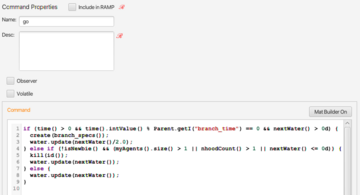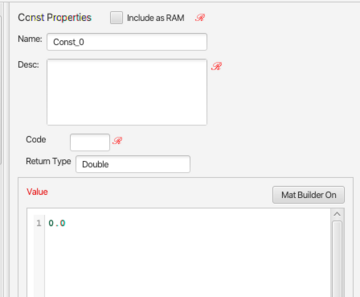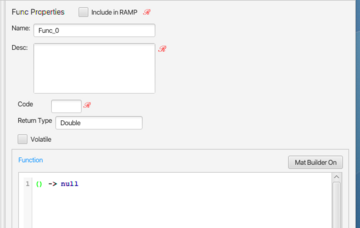Difference between revisions of "Designer Component Guide"
| Line 45: | Line 45: | ||
[[File:dfunction.png]] A Function contains a Function squib that is executed only when the function defined by the squib is invoked on a set of arguments. Function squibs are defined [[Quick Programming References#Function | here]]. | [[File:dfunction.png]] A Function contains a Function squib that is executed only when the function defined by the squib is invoked on a set of arguments. Function squibs are defined [[Quick Programming References#Function | here]]. | ||
;Property Pane | ;Property Pane | ||
[[File:funcProp.png|360px|thumb|right]] Contains a single <span style="color:# | [[File:funcProp.png|360px|thumb|right]] Contains a single <span style="color:#21a0ff">'''Function'''</span> squib. Return type is required. | ||
;Squib Reference | ;Squib Reference | ||
:To | :To invoke a Function use the following format: | ||
::<name>() | ::<kbd><name>(arg<sub>0</sub>, arg<sub>1</sub>, ... arg<sub>n</sub>)</kbd> | ||
:where the args match the formal parameters in number and type. | |||
Revision as of 19:08, 7 June 2022
Introduction
This guide documents the Component set distributed with Numerus Designer. Numerus Designer models are constructed out of Components, which are visual tokens that are placed on the Design Canvas.
To Place a Component on the Designer Canvas
- Press the left mouse button on the desired Component in the Component Palette.
- Drag the component from the component menu onto the Design Canvas.
- A default name will be provided; Alt-click on the name to change it (or change it in the Property Pane).
- The new component must be programmed; this may require the programming of squibs. See Programming References for a discussion of squib programming.
Referencing Components in Squibs
Many Components yield values that can be used (along with primops) to perform the required computations in squibs. Within a given Capsule, each value-yielding component can be referenced by its name. Referencing Components in other Capsules is different and will be discussed elsewhere.
In this document, the sections labeled Squib Reference describe the format used to access values from each Component type[1]. In these sections the notation <name> refers to the Component's name.
Basic Components
Command
 A command contains code that is executed once per time step. Commands do not return values; rather they operate by altering simulation state, often through the execution of some primitive operator. One common use for a Command is during program development, where the Console.log primop is used to print useful values to the console. Another important role is in the agent life cycle, where Commands may contain code used to create or terminate agents, or move them in their environment.
A command contains code that is executed once per time step. Commands do not return values; rather they operate by altering simulation state, often through the execution of some primitive operator. One common use for a Command is during program development, where the Console.log primop is used to print useful values to the console. Another important role is in the agent life cycle, where Commands may contain code used to create or terminate agents, or move them in their environment.
- Property Pane
Contains a single Command squib.
- Observer
- If checked, this Command is not executed during the normal Simulation cycle, but rather intentionally from a remote Observer, such as an Agent Vector Component, or from some other Component.
- Volatile
- Normally Components are executed only once per cycle. If Volatile is checked, it enables multiple executions.
- Squib Reference
- Generally not used since Commands execute automatically. To invoke a Command from a squib use the following format:
- <name>()
Constant
![]() A Constant contains a Supplier squib that is executed once when the simulation is reset. The value is retained for the life of the simulation.
A Constant contains a Supplier squib that is executed once when the simulation is reset. The value is retained for the life of the simulation.
- Property Pane
Contains a single Supplier squib. Return type is required.
- Squib Reference
- To retrieve a Constant use the following format:
- <name>()
Function
![]() A Function contains a Function squib that is executed only when the function defined by the squib is invoked on a set of arguments. Function squibs are defined here.
A Function contains a Function squib that is executed only when the function defined by the squib is invoked on a set of arguments. Function squibs are defined here.
- Property Pane
Contains a single Function squib. Return type is required.
- Squib Reference
- To invoke a Function use the following format:
- <name>(arg0, arg1, ... argn)
- where the args match the formal parameters in number and type.
- ↑ This process is technically called reification.


